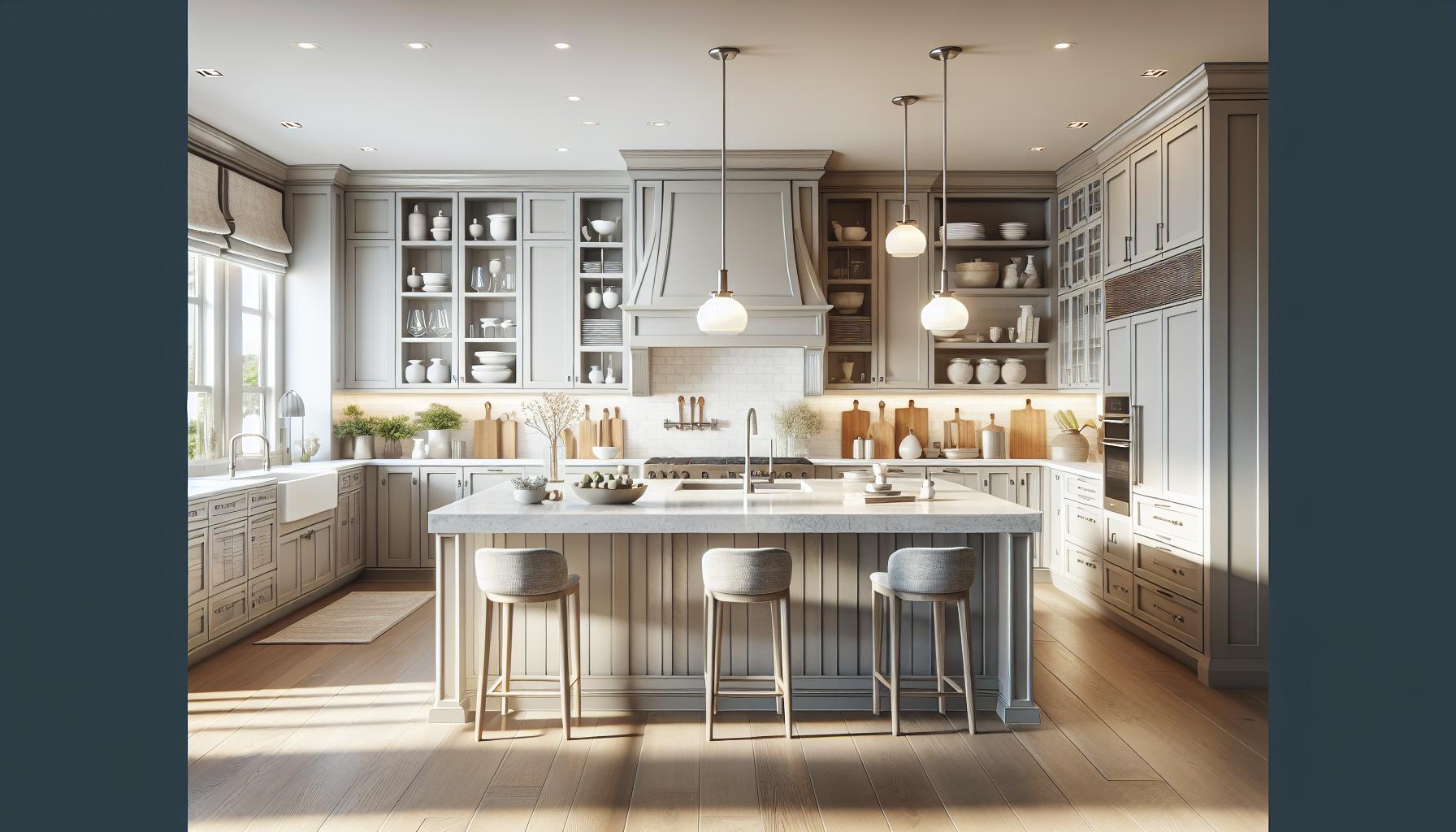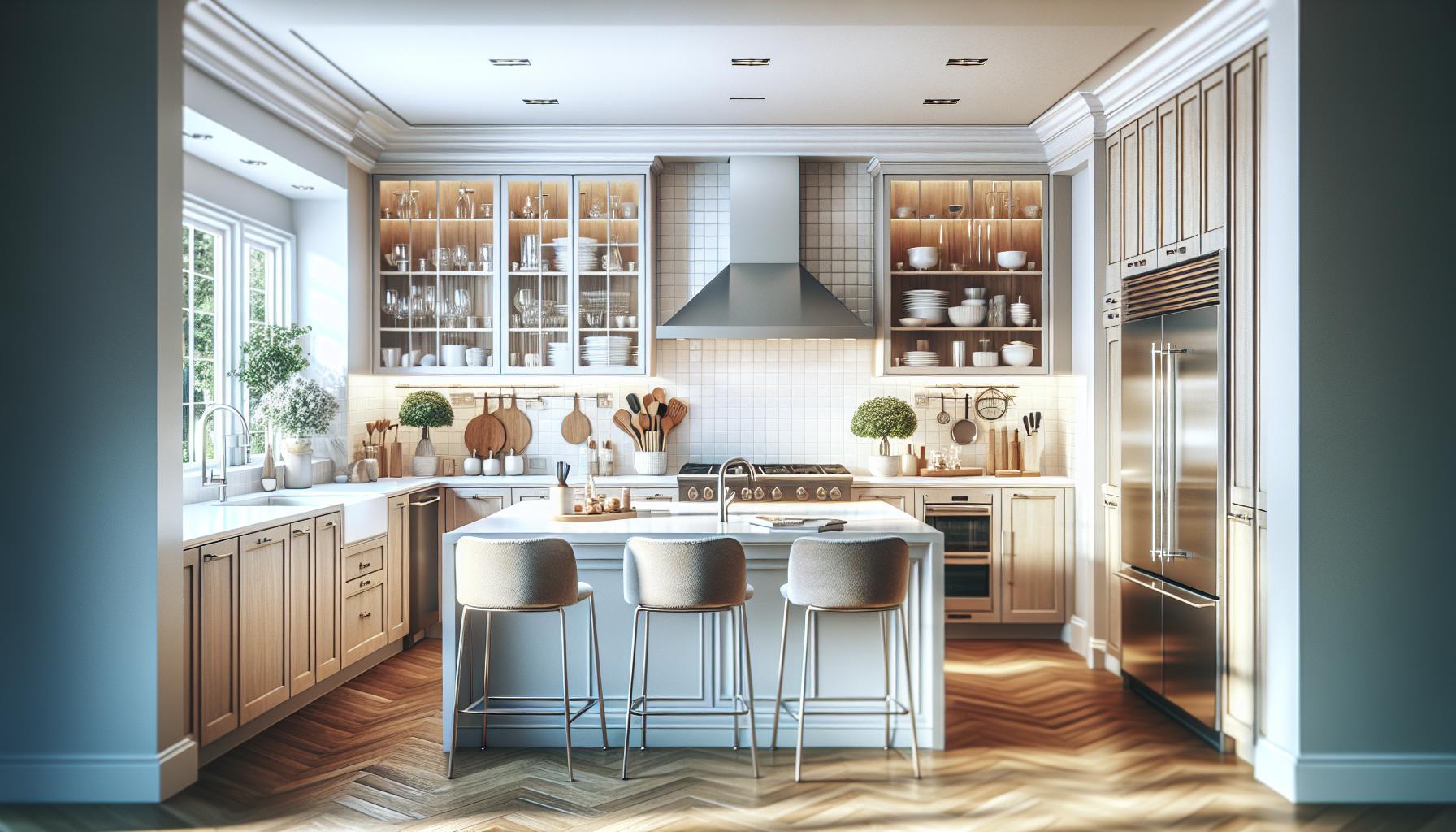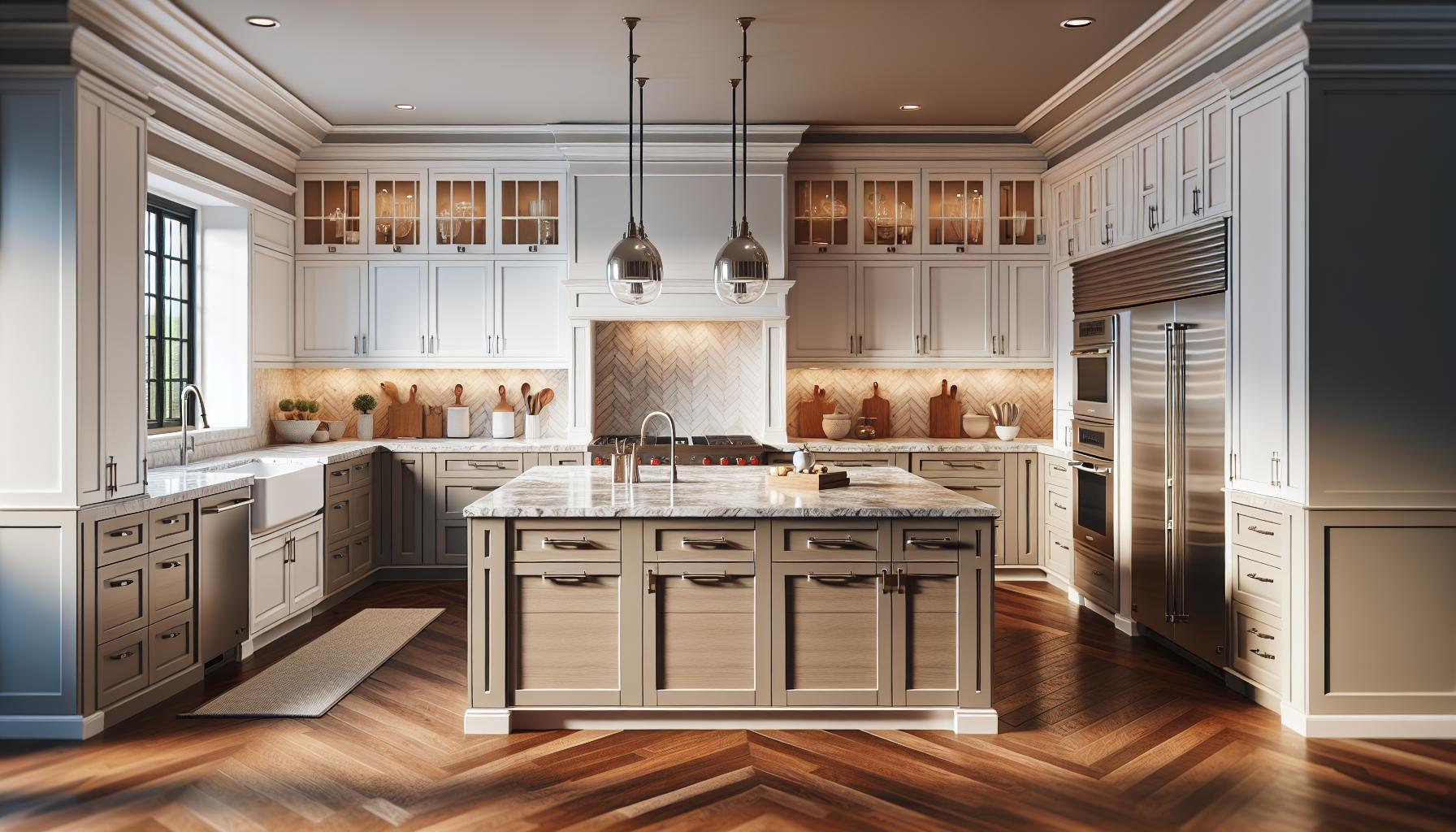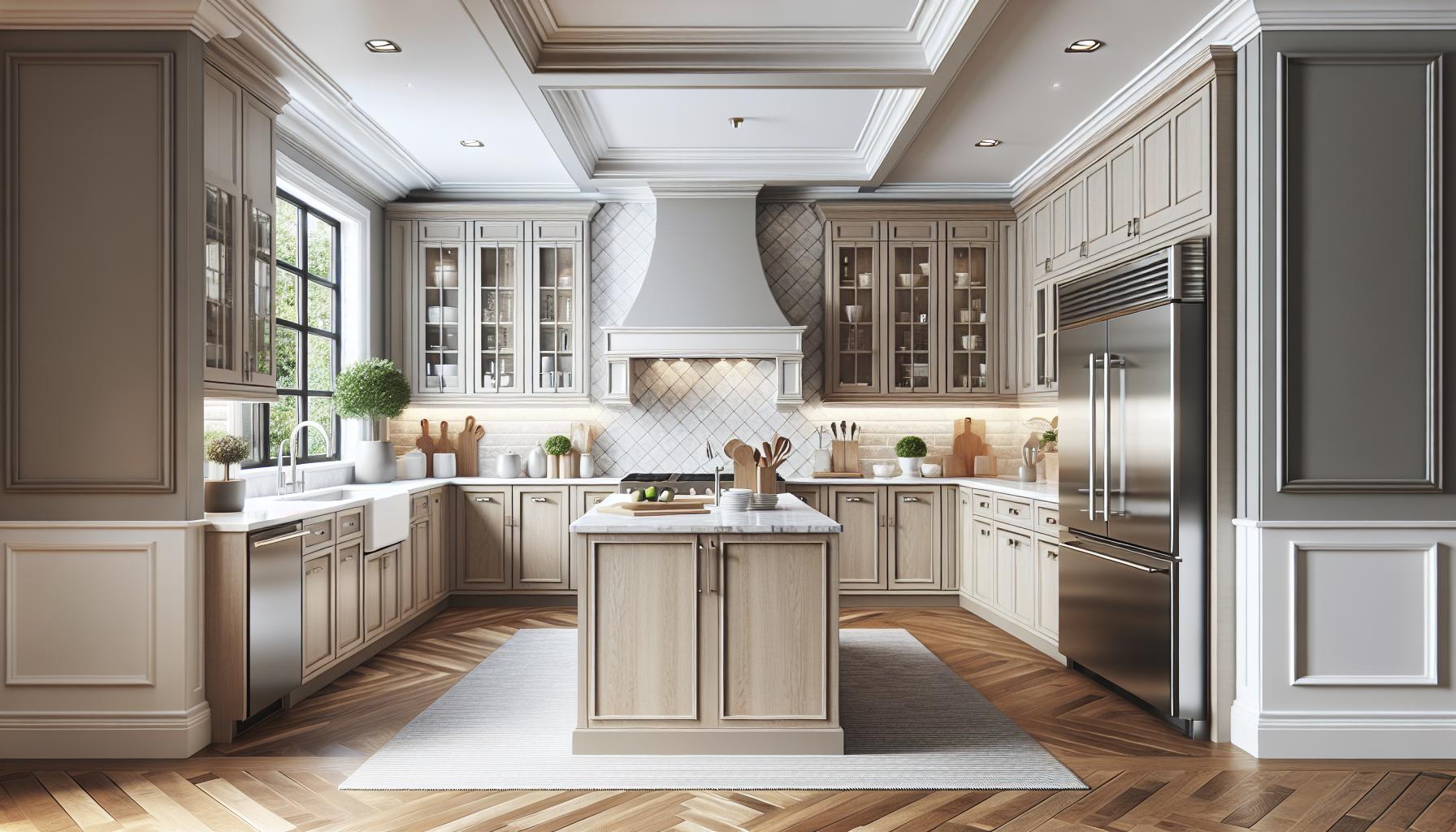
When it comes to kitchen design, finding the perfect balance between traditional charm and modern flair can be a challenge. That’s where transitional interior design steps in, offering a harmonious blend of classic and contemporary elements. As someone who’s spent years exploring the nuances of interior design, I’ve found that transitional kitchens provide a versatile and timeless aesthetic that appeals to a wide range of tastes.
In a world where design trends come and go, the transitional style remains a steadfast choice, bringing together the best of both worlds. It’s all about creating a space that’s functional yet elegant, with clean lines and a neutral palette that can easily adapt to changing preferences. Whether you’re renovating an outdated kitchen or starting from scratch, this design approach offers endless possibilities for personal expression and creativity. Let’s dive into what makes kitchen transitional interior design so captivating and practical.
Key Takeaways
- Harmonious Blend: Kitchen transitional interior design combines classic and contemporary elements, creating a versatile and timeless aesthetic that appeals to diverse tastes.
- Neutral Color Palette: Dominated by whites, greys, and beiges, transitional kitchens use a neutral palette that allows accent pieces to stand out and adapts to changing trends.
- Functionality: Focused on creating practical spaces, transitional kitchens optimize efficiency with thoughtful layouts, durable materials, and modern appliances that blend style with utility.
- Material and Finish Choices: The design features a mix of classic wood tones, sleek modern hardware, and durable countertops like quartz and granite, ensuring a cohesive and elegant look.
- Timeless and Adaptable: By harmoniously integrating traditional and modern elements, transitional kitchens offer enduring appeal and flexibility to adapt to evolving personal styles.
Kitchen Transitional Interior Design
Kitchen transitional interior design bridges classic and contemporary styles, offering a seamless integration of both worlds. It embodies balance by merging ornamental and sleek elements, providing a space that’s both functional and beautiful. This design style rejects extremes, incorporating the best aspects of traditional and modern aesthetics for a cohesive and adaptable environment.
Cabinetry in transitional kitchens often features classic wood finishes paired with modern hardware, creating a harmonious look. Countertops typically use durable materials like quartz or granite, with subtle patterns that complement the overall aesthetic. Lighting fixtures exhibit a mix of traditional forms and contemporary finishes, ensuring ambient and task lighting work in unison.
Color palettes in transitional kitchens favor neutral tones, including whites, greys, and beiges, allowing for accent pieces to stand out. This approach supports a timeless ambiance, capable of evolving with changing trends and personal tastes. Flooring often blends warmth with practicality, using wood or tile to establish a foundational base for the design.
Appliances in this design are chosen for their utility and style, typically incorporating stainless steel for a modern touch. These elements enhance the kitchen’s function without detracting from its aesthetic appeal, making every aspect of the space work together harmoniously.
Key Characteristics of Transitional Kitchens

Transitional kitchens excel in combining timeless charm with contemporary flair. By focusing on balance and simplicity, they offer a sophisticated and adaptable environment.
Blend of Traditional and Modern Elements
In transitional kitchens, elements harmonize classic and contemporary styles. For example, cabinetry often combines traditional wood finishes with sleek modern hardware. An elegant kitchen island might feature a classic shape with a modern surface. These combinations create a cohesive space that resonates with both nostalgic warmth and modern minimalism.
Neutral Color Palettes
Neutral tones form the foundation of transitional kitchens. Colors like white, beige, and gray dominate the space, providing a serene backdrop for other design elements. By using neutral hues, designers allow accent pieces, such as barstools or artwork, to stand out. This color scheme adapts easily to changes, ensuring the kitchen remains timeless and versatile.
Focus on Functionality
Functionality takes center stage in transitional kitchens. Efficient layouts promote ease of use and maximize space, such as open shelving alongside closed cabinetry for accessible storage. Durable materials like quartz or granite ensure surfaces endure daily use. Appliances that combine utility with sleek designs, often in stainless steel, enhance both functionality and overall aesthetic.
Popular Materials and Finishes

In transitional kitchen design, materials and finishes create a harmonious blend of traditional and modern elements. Thoughtful choices elevate the kitchen’s aesthetic and functionality.
Cabinetry Choices
Cabinetry in transitional kitchens typically combines classic wood tones with contemporary finishes. I often see white or gray painted cabinets paired with natural wood accents. This mix provides a timeless yet updated look. Hardware selection plays a crucial role; sleek stainless steel or brushed nickel handles complement the cabinetry’s refined elegance.
Countertop Options
Countertops serve as a central element in transitional kitchens, merging practicality with style. I frequently recommend durable options like quartz and granite for their resistance to stains and scratches, while marble offers a touch of luxury. Choosing a subtle pattern or a solid color enhances the overall cohesive design.
Flooring and Lighting
Flooring in transitional kitchens usually features hardwood or stone, providing a warm and inviting foundation. Engineered wood offers durability and easy maintenance. Lighting choices are vital, with pendant lights above islands and under-cabinet lighting creating depth and focus. Incorporating dimmable fixtures adjusts the ambiance as needed.
Designing a Transitional Kitchen

Crafting a transitional kitchen requires a blend of style and functionality. It’s essential to incorporate both aesthetic balance and practical elements to achieve a harmonious space.
Balancing Aesthetics and Practicality
Achieving balance in a transitional kitchen involves careful selection of both design elements and functional components. I focus on maintaining clean lines and a neutral color palette while integrating traditional and modern materials. Cabinetry often combines classic wood tones with sleek hardware. Choosing durable countertop materials like quartz or granite ensures longevity and complements the overall design. Ensuring workspaces are uncluttered allows for both aesthetic appeal and practical use, enhancing the kitchen’s versatility.
Tips for Selecting Appliances and Fixtures
Selecting appliances and fixtures is crucial in uniting style with utility in a transitional kitchen. I prioritize utility without sacrificing style by opting for stainless steel appliances that offer both visual and functional benefits. Fixtures, such as faucets and lighting, are most effective in brushed nickel or chrome finishes for a cohesive look. A focus on energy-efficient models helps maintain functionality while being mindful of sustainability. By ensuring fixtures harmonize with cabinetry and other elements, the kitchen remains a unified and practical space.
Benefits of Transitional Kitchens
Transitional kitchens offer a seamless blend of traditional and contemporary design elements, making them a popular choice for those seeking both style and functionality.
Versatility in Style
This design embodies flexibility, as it combines aspects from different styles to fit a variety of tastes. The use of neutral colors and adaptable design features like blending classic wood cabinets with modern hardware creates a balanced aesthetic. For example, you might see a traditional kitchen island paired with modern stainless steel appliances, allowing personalization without compromising coherence.
Timeless Appeal
Transitional kitchens maintain their allure over time through their timeless nature. Clean lines paired with a neutral color palette ensure these kitchens remain stylish as trends evolve. Choosing durable materials like quartz countertops and hardwood flooring enhances longevity, while maintaining a sophisticated look. Elements like brushed nickel fixtures and understated lighting further contribute to an elegant and enduring environment.
Traditional and Modern Elements in Design
Transitional kitchen design offers a perfect blend of traditional and modern elements, creating a space that’s both functional and stylish. Its versatility allows it to appeal to a wide range of tastes, making it an ideal choice for many homeowners. With its focus on balance, simplicity, and timeless charm, a transitional kitchen can effortlessly adapt to changing trends while maintaining its elegance. Whether you’re renovating or designing a new kitchen, embracing this style can provide a sophisticated and enduring environment that meets both aesthetic and practical needs.
